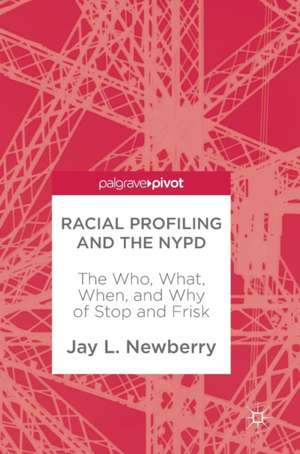Racial Profiling and the NYPD: The Who, What, When, and Why of Stop and Frisk
Autor Jay L. Newberryen Limba Engleză Hardback – 29 iun 2017
| Toate formatele și edițiile | Preț | Express |
|---|---|---|
| Paperback (1) | 408.66 lei 6-8 săpt. | |
| Springer International Publishing – 12 mai 2018 | 408.66 lei 6-8 săpt. | |
| Hardback (1) | 416.54 lei 6-8 săpt. | |
| Springer International Publishing – 29 iun 2017 | 416.54 lei 6-8 săpt. |
Preț: 416.54 lei
Nou
Puncte Express: 625
Preț estimativ în valută:
79.71€ • 85.23$ • 66.46£
79.71€ • 85.23$ • 66.46£
Carte tipărită la comandă
Livrare economică 18 aprilie-02 mai
Preluare comenzi: 021 569.72.76
Specificații
ISBN-13: 9783319580906
ISBN-10: 3319580906
Pagini: 79
Ilustrații: XI, 77 p. 6 illus. in color.
Dimensiuni: 148 x 210 mm
Greutate: 0.3 kg
Ediția:1st ed. 2017
Editura: Springer International Publishing
Colecția Palgrave Macmillan
Locul publicării:Cham, Switzerland
ISBN-10: 3319580906
Pagini: 79
Ilustrații: XI, 77 p. 6 illus. in color.
Dimensiuni: 148 x 210 mm
Greutate: 0.3 kg
Ediția:1st ed. 2017
Editura: Springer International Publishing
Colecția Palgrave Macmillan
Locul publicării:Cham, Switzerland
Cuprins
1. Introduction.- 2. In the Shadow of Lady Liberty.- 3. Broken Windows or Breaking Communities.- 4. The Impact of Broken Window on Police Practices in New York City.- 4. Analytical Methods.- 5. Analytical Results.- 6. Discussion and Conclusion.
Notă biografică
Jay L. Newberry is Assistant Professor of Geography at Binghamton University
Textul de pe ultima copertă
This book analyzes New York City’s stop-and-frisk data both pre- and post-constitutionality ruling, examining the existence of both profiling and unequal treatment among the three largest groups identified in the database: Blacks, Whites, and Hispanics. The purpose for using these two time periods is to determine which group(s) benefited the most from the ruling. This research goes beyond standard statistics to identify the place that race holds in contributing to the stop disparities. Specifically, this research will adds a spatial element to the numbers by analyzing the determinants of stop location by race, applying a principal component analysis to a mixture of census and stop-and-frisk data to determine the influence of location on stops by race. The results present a way of determining the plausibility of stops being the product of racial profiling–or just a matter of happenstance.
Caracteristici
Appeals to urban geographers, sociologists and criminal justice researchers examining the rise of the stop-and-frisk policy internationally Grounded in empirically research and statistically strong analysis of census data Answers the question of whether or not the constitutional ruling of stop-and-frisk has had an impact on the way in which stop-and-frisk is carried out Includes supplementary material: sn.pub/extras Includes supplementary material: sn.pub/extras
